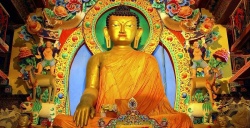Meditation on the Buddha Infinite Life Sutra
Meditation on the Buddha Infinite Life Sutra
観無量寿経 (Chin Kuan-wu-liang-shou-ching; Jpn Kammuryoju-kyo )
Abbreviated as the Meditation Sutra. A sutra said to have been translated into Chinese by Kalayashas between 424 and 442. The Buddha Infinite Life is also known as the Buddha Amida.
This sutra is one of the three basic scriptures of the Pure Land school, which reveres that Buddha. According to the Chinese text, Shakyamuni Buddha expounded it in the royal palace at Rajagriha in Magadha, India, at the request of Vaidehi, who was grieving in prison over the evil acts of her son Ajatashatru, who had also imprisoned his father, King Bimbisara, in order to become the new king. Shakyamuni employed supernatural powers to show her various pure lands, including Amida's Pure Land of Perfect Bliss. Since Vaidehi preferred Amida's Pure Land to all the others, Shakyamuni expounded sixteen types of meditation to attain rebirth there.
This sutra inspired Shan-tao (613-681), a patriarch of the Pure Land school in China, when he was young, and he later wrote The Commentary on the Meditation on the Buddha Infinite Life Sutra.
This commentary moved Honen to establish the Pure Land ( Jodo) school in Japan based on the sole practice of reciting the name of Amida Buddha. Only one Chinese translation of the sutra exists, and neither a Sanskrit text nor a Tibetan version is extant. Hence contemporary scholars view this sutra as having originated in either [[Wikipedia:Central Asia|Central Asia]] or China.
